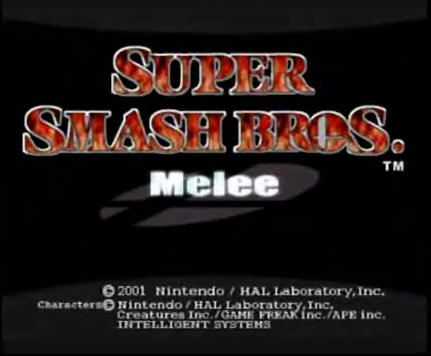
After the success of Super Smash Bros for the Nintendo 64, the sequel, Super Smash Bros. Melee hit the Nintendo GameCube over two years later on December 3, 2001 in North America.
If you loved Super Smash Bros, then you probably loved its sequel. The improvements made in Super Smash Bros. Melee were substantial and left many gamers satisfied.
New features included an Event Mode, where you try different challenges such as Fire Emblem Pride. You could also take pictures by plugging in a controller to the fourth port of the GameCube. In the game you could collect trophies that resembled characters and items. Gamers could read about its history once you achieved them.
The characters roster was greatly expanded, you could now dodge even in midair, and the characters had more move sets that made the game a more technical fighter then it used to be. There was also of course the graphical upgrade, the new items that were scattered across the game, and new stages from each Nintendo universe.
You could even play enhanced remakes of stages from the previous Smash game as well. One of the coolest new features in the game was the Adventure Mode where you could play through stages based on each character from their universe.
Remember the stage 1-1 from Super Mario Bros? Ever thought to yourself playing through it as Pikachu from Pokémon, or Link from The Legend of Zelda? That was the weird nostalgia that Adventure Mode brought, playing through it with different characters. At the end of the Level would be a boss from that video game’s universe.
For example, in the end of the Super Mario Bros stage you have to fight both Mario and Princess Peach on top of her castle from Super Mario 64, which is also a playable stage in the game.
This game was a dream come true, not only as a fighting game but also because of Adventure Mode that made the game a platformer in its own unique way.
I bet you’d never ever picture a situation where a Like Like from The Legend of Zelda is strangling a Mewtwo from Pokémon. Things you never thought were possible, were possible because of this game.
The normal Arcade Mode was kept from the previous game where you just beat each other to death with stocks. Same basic concept, which didn’t need to be improved upon. At the end of the stage and in Adventure Mode, if you beat it in a certain time limit you get introduced to a completely new original Villain after you beat the iconic Smash boss, the infamous Master Hand.
The frightening Giga Bowser. If you thought Bowser was kind of scary, gamers were in for a rude awakening when they met this mastodon. About 10x Bowers original size, looking scarier then ever with sharper claws, teeth, and spikes. Just reaching Giga Bowser was a challenge, fighting him was even more of a challenge.
Defeating Giga Bowser gave you a trophy of the gargantuan. If Smash enthusiasts thought completing Adventure Mode was difficult, they had another thing coming with Event Mode. Getting past all 50 events unlocked the secret 51st event.
Assembling some of the cruelest villains in history, not only do you have to fight to the death with Giga Boswer, but with Ganondorf and Mewtwo as well.
That’s right, Giga Bowser, Ganondorf, and Mewtwo teamed up to take you down in one of the most epic fights in history. Giga Bowser’s huge size, Ganandorf’s strength and Mewtwo’s physical abilities made it seem almost impossible to win.
Overall this game was amazing. If you haven’t picked it up I’d recommend you do so if you’re a diehard Nintendo fan because you will not be disappointed. This game took up a lot of time out of my life when I first got the game back in 2001 and I don’t regret getting it not one bit.
This is without a doubt my favorite Smash game out of the three released so far.
